Power Shift - Bike Sharing in Boston
Air Date: Week of November 9, 2012
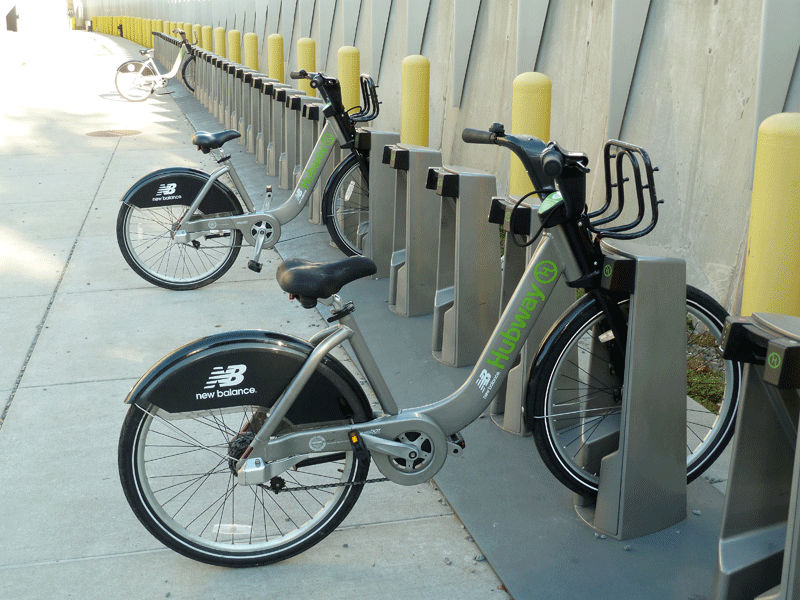
By the end of the morning rush hour there are just 3 bikes left at North Station. The busy commuter line starts the day with 47 bikes, and is replenished as many as three times. (Photo: Bobby Bascomb)
Bike share programs are increasingly popular, with nearly 200 world wide. In Boston the Hubway allows riders to take out a sturdy bike for 30 minutes at a time to help commuters the last mile of their commute. Living On Earth's Bobby Bascomb reports.
Transcript
CURWOOD: And as Caroline Sampanaro was saying - a bicycle was one of the few reliable ways to get around in the aftermath of Sandy. But New Yorkers would have found it much more convenient if the Big Apple had already joined the dozens of cities worldwide with a bike-sharing program. Boston – where Living on Earth is based – has one, and Bobby Bascomb went to check it out.
BASCOMB: In Boston there are a few basic ways to get around the city. You can walk or drive.
[SFX TRAFFIC SOUNDS]
BASCOMB: You can take the subway.
[SFX: ANNOUNCER: THE DESTINATION OF THIS TRAIN IS BRAINTREE. NO SMOKING PLEASE]
BASCOMB: Or you can take the Hubway, Boston’s public bike system.
MAN: Hey how are you?!
BASCOMB: I’m good, how are you?
MAN: I’m doing well!
BASCOMB: It’s a sunny fall day at the North Station TD Garden Center. This is where the Celtics play basketball and where thousands of commuters arrive in Boston from the North Shore. Like a lot of people, Peter Dolan uses the Hubway for the last mile of his commute.
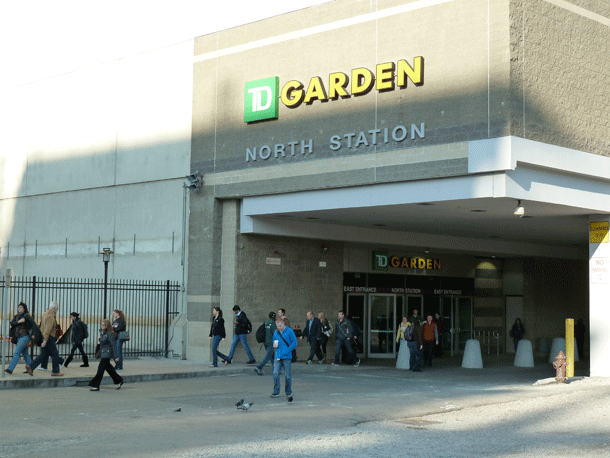
The TD Garden, North Station is where the Celtics play and a central rail hub for commuters in Boston. (Photo: Bobby Bascomb)
DOLAN: It’s such a nice day and it’s about a 15-minute ride to my office from here so I think I ought to take advantage of it before they put them away for the winter. I think it’s a nice relaxing way to start the morning.
BASCOMB: The Hubway is a system of over 1,000 sturdy bikes at 108 docking stations across Boston and the adjoining cities of Somerville, Cambridge and Brookline. For $85 a year Hubway users get a key fob about the size and shape of a flash drive. Rochelle Borgo, from Salem, explains how it works.
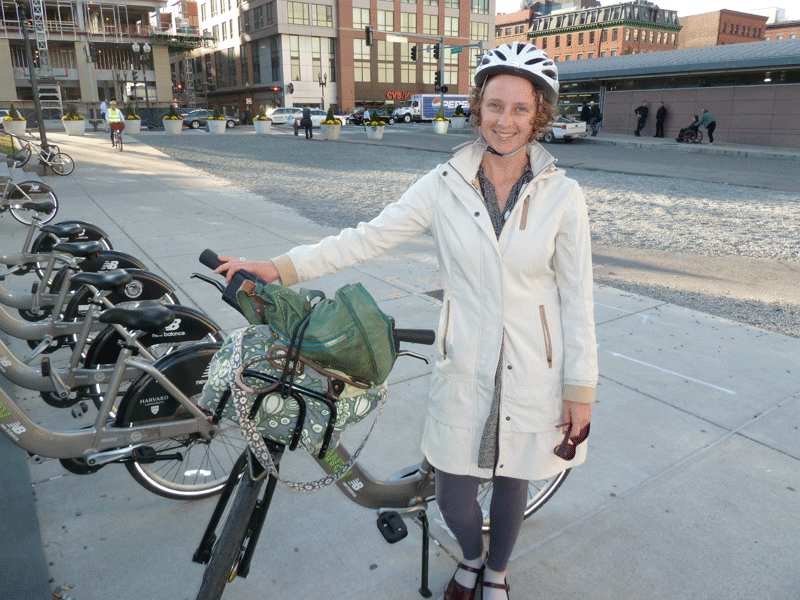
Rochelle Borgo uses the hubway for the last mile of her commute from Salem to downtown Boston. (Photo: Bobby Bascomb)
BORGO: You just insert it into the opening at any dock. It turns green if the bike is available. It turns red if the bike is in need of repairs. And it’s unlimited 30-minute rides throughout the city. As a commuter, I can get everywhere I need to go under that 30 minutes. I’ve only had to pay for a ride 2 or 3 times. Actually there’s one time I got charged because there were no docks available here. And when there are no docks available you either have to wait or ride to another station.
BASCOMB: For Borgo, riding a bike is just more pleasant than taking the subway.
BORGO: The idea of being underground for 20 minutes when it’s still sunny and nice and not pouring and not snowing is just moderately depressing and this is such a great liberating option. It’s just another way to feel like a ten year old again as well. You get to play and be free and be in the fresh air. I love it!
BEVERLY: It’s awesome!
BASCOMB: Jim, from Beverly, says a hubway bike is the fastest way for him to get around the city.
BEVERLY: My office is down by South Station. It’s at least a 15 minute walk and the Hubway is a 6 minute ride.
BASCOMB: Is there a train that goes down there too?
BEVERLY: Oh God no! You’d have to take the green line to the red line or the orange line. It’s all sorts of connections. It’s a pain in the ass. I catch so many trains now. Trains I used to miss when I was walking. It’s incredible, get home to the wife and family so much faster.
BASCOMB: The North Station commuters were so enthusiastic I had to try it myself. For 5 dollars, a day user gets a 5 digit code and can use the bikes for 30-minutes at a time for 24 hours.
[CODE BEEPS UNDER PREVIOUS GRAPH THEN BIKING SOUNDS UNDER NEXT GRAPH BELL RINGS]
BASCOMB: The hubway bikes have three gears and a big fat seat. Your grandmother could ride one and be comfortable. As I zipped by cars stuck in traffic I thought… ‘Suckers! You could be riding a bike!’
I rode over to Boston Common and the State House and then to the Boston Public Library at Copley Square. Then turned the bike in before I got charged for going over 30 minutes. Then I headed over to the Boston City Hall to meet Kristopher Carter, interim director of Boston Bikes, and advisor to the Mayor.
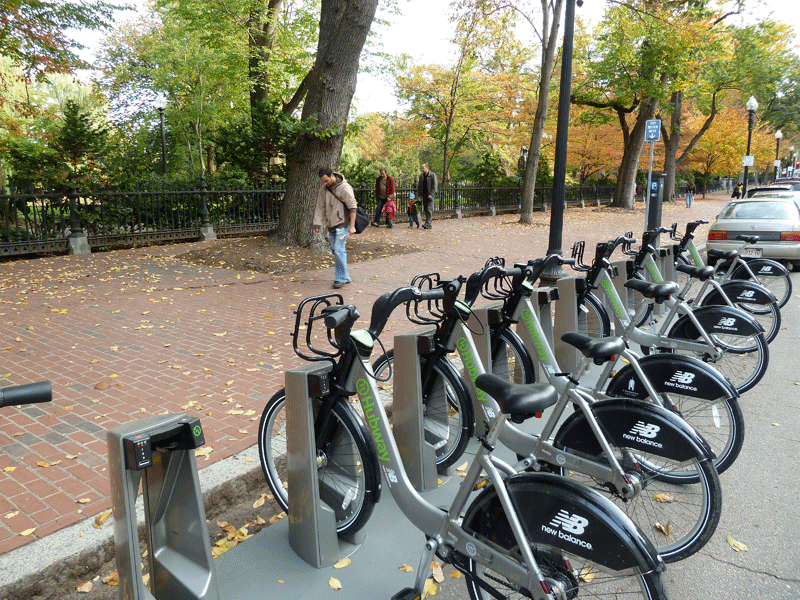
The Hubway station near the Boston Common. (Photo: Bobby Bascomb)
CARTER: There’s definitely an environmental component of it, where we’re looking at, you know, improve air quality and reduce carbon emissions. There’s also a healthy lifestyle component we’re looking at too. Some of the funding is targeted around anti-obesity. You know if you can get to work or get to school by pedaling a bicycle that’s certainly one way of tackling the epidemic we have in this country.
BASCOMB: It’s hard to say how much weight has been lost or carbon reduced by the more than 600,000 Hubway trips taken so far. What is certain is the price. The initial investment for the Hubway was roughly six million dollars. It’s in the red right now but Carter expects it will start turning a profit within three years. Start up funding came from state and federal grants as well as corporate sponsors led by the athletic shoe company New Balance, which gave 600,000 dollars. Matthew Le Bretton is director of public affairs for New Balance Athletic Shoe Company.
LE BRETTON: We really believe, as a company, that getting people moving no matter how they do it, whether it’s walking up a flight of stairs or riding a bike, is really important to our overall health and to our city’s health. Alternative modes of transportation is a great thing and we’re proud to sponsor that and support it.
BASCOMB: In the last 5 years Boston has added roughly 58 miles of bike lanes. There are plans to extend the bike share program to other neighborhoods such as Jamaica Plain and Roxbury.
So far this year in Boston there have been 450 accidents involving cars and bikes, including three fatalities. No Hubway users were killed and only two were involved in accidents that required EMS services. One criticism leveled at Hubway is that it doesn’t provide helmets. But Kristopher Carter says they are working on it.
CARTER: We’re working with a group out of MIT that’s formed a company to do helmet vending machines. We are hopefully going to be able to pilot one of those vending machines next spring.

Day users can swipe their credit card and for five dollars have access to a bike for 24 hours. (Photo: Bobby Bascomb)
BASCOMB: Another problem is ensuring that bikes are always available when and where the commuters need them. That’s where Myles Dakan comes in.
DAKAN: That’s my usual job is to go around and make sure the bikes are where they need to be. Often I’m on the morning shift so making sure people going on their morning commute have bikes where they need them and places to put them where they’re heading.
BASCOMB: Myles works for Alta Bike Share, the contractor that administers the program and maintains the bikes. The hubway dock at North Station empties out two or three times during the morning rush hour so he’s busy driving vans full of bikes to replenish the racks. Mackenzie Stunkard is the Fleet Coordinator, or dispatcher for the Hubway. She sits in front of a computer with a map of the city.
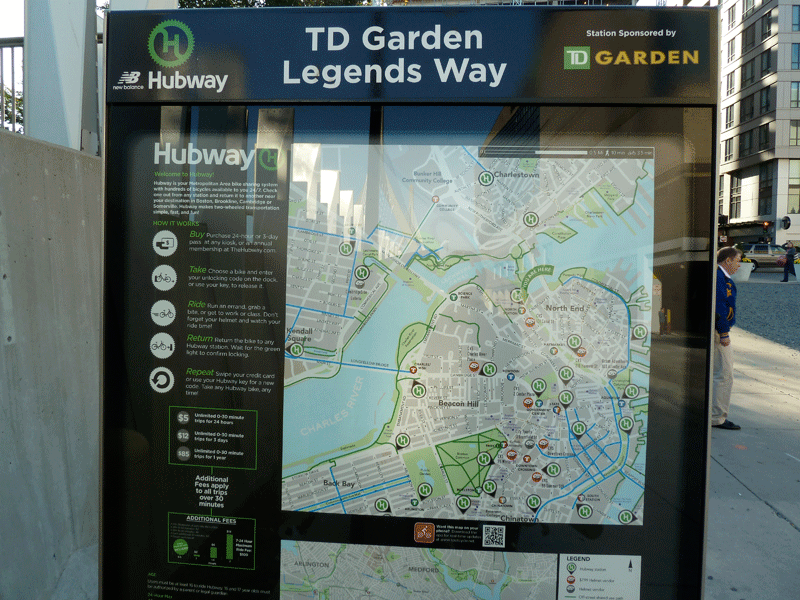
A map at each Hubway station shows users where they can return their bikes. (Photo: Bobby Bascomb)
STUNKARD: This is a live map of the system. So it has an up-to-date view of all the bikes. And then I also have GPS locations of all the drivers.
BASCOMB: So, each little green dot on the map here represents a station?
STUNKARD: Correct and it’s shaded gray where there are available docks and green where there are available bikes.
BASCOMB: Hubway users have access to the same information on the website. And there’s a smart phone app. so riders can see in real time where there are bikes and docking stations available. It’s that kind of technology that’s allowed bike share programs to really take off. Scott Mullen is General Manager of the Hubway.
MULLEN: Bike sharing in general really got a boost in ’06. It’s called bike sharing 3.0. It’s credit-card transactions. A really secure, robust locking system. And that was really Velib in Paris. I think to this day they have about 20,000 bicycles. It’s really a mode whose time has come.
BASCOMB: Mullen says bikes are also a critical component for emergency management that will help make the transportation system more resilient. Most of the Hubway racks are solar-powered so bikes can still be released and returned if the electricity grid goes down.
MULLEN: After the blackout that happened a few years ago that literally crippled most of the East Coast and New York City was in the dark, most of my friends said ‘it didn’t phase me at all. I just rode my bike like I normally do. I just had more pedestrians to watch out for.’
BASCOMB: There are currently about 25 bike share programs in the US and nearly 200 world wide, from China to Germany to Argentina. Mullen says that number is only going to go up.
MULLEN: Bike sharing is a rocket ship. Every smart city is looking at it. If you think about transit investment it’s the best bang for the buck by a factor of 100. What’s the most efficient way to move the most amount of people? And then if you think about the public health aspects. I don’t know of many other modes that are as much a magic bullet as cycling is.
[BIKE RIDING SOUNDS BELL]
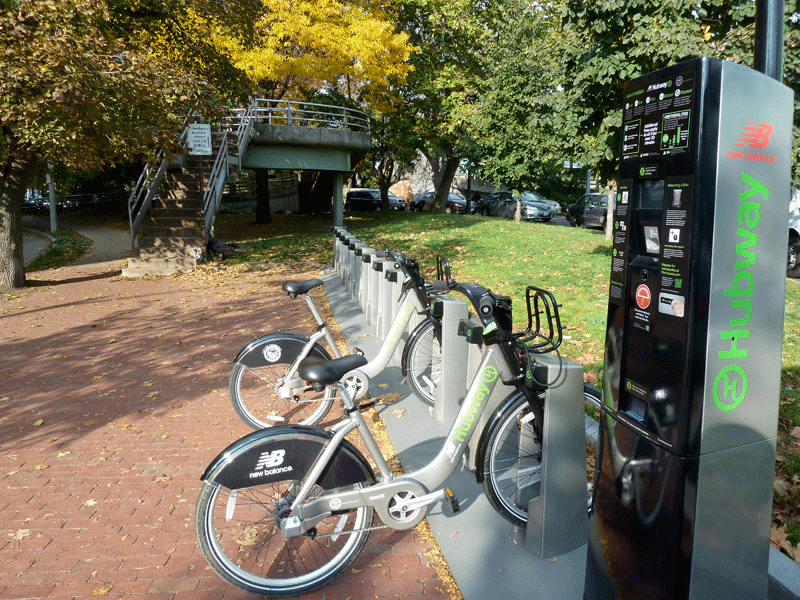
The Hubway station near the Charles River. (Photo: Bobby Bascomb)
BASCOMB: The Hubway bikes will be out on the streets here in Boston until the end of November. Then they’ll go back to the warehouse for a thorough tune up and winter storage. The 10,000 commuters at North Station and around the city will just have to wait for the spring thaw in March to get back on their bikes. For Living on Earth, I’m Bobby Bascomb.
Links
Federal Report on Bike Sharing in the US and Guide to Starting Bike Share Programs
Living on Earth wants to hear from you!
Living on Earth
62 Calef Highway, Suite 212
Lee, NH 03861
Telephone: 617-287-4121
E-mail: comments@loe.org
Newsletter [Click here]
Donate to Living on Earth!
Living on Earth is an independent media program and relies entirely on contributions from listeners and institutions supporting public service. Please donate now to preserve an independent environmental voice.
NewsletterLiving on Earth offers a weekly delivery of the show's rundown to your mailbox. Sign up for our newsletter today!
 Sailors For The Sea: Be the change you want to sea.
Sailors For The Sea: Be the change you want to sea.
 The Grantham Foundation for the Protection of the Environment: Committed to protecting and improving the health of the global environment.
The Grantham Foundation for the Protection of the Environment: Committed to protecting and improving the health of the global environment.
 Contribute to Living on Earth and receive, as our gift to you, an archival print of one of Mark Seth Lender's extraordinary wildlife photographs. Follow the link to see Mark's current collection of photographs.
Contribute to Living on Earth and receive, as our gift to you, an archival print of one of Mark Seth Lender's extraordinary wildlife photographs. Follow the link to see Mark's current collection of photographs.
 Buy a signed copy of Mark Seth Lender's book Smeagull the Seagull & support Living on Earth
Buy a signed copy of Mark Seth Lender's book Smeagull the Seagull & support Living on Earth

